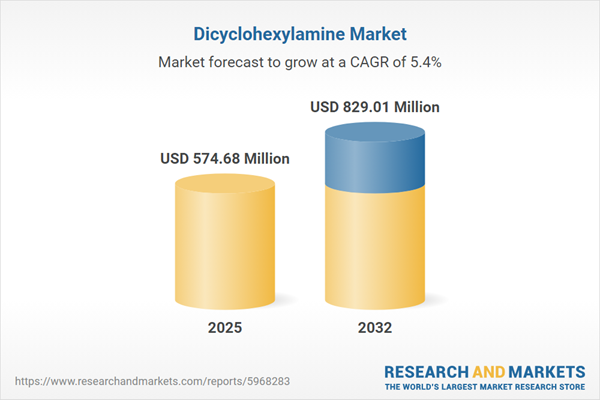Speak directly to the analyst to clarify any post sales queries you may have.
Dicyclohexylamine plays a pivotal role in strengthening specialty chemical supply chains, enabling senior leaders to manage procurement risk and maintain agility in tightly regulated and fast-changing markets. This report provides targeted, actionable insights designed to support informed decision-making at the executive level.
Market Snapshot: Global Dicyclohexylamine Market Trends
The global dicyclohexylamine market is valued at USD 545.90 million and is projected to reach USD 574.68 million in the next year, with long-term growth expected to surpass USD 829.01 million by 2032. A compound annual growth rate of 5.36% underscores robust demand across core applications. Growth is driven by dicyclohexylamine’s increasing importance as a specialty intermediate, ongoing advances in process automation, and sustained reliance within pharmaceutical and industrial manufacturing. Strategic focus remains on procurement optimization and production efficiency as competition intensifies across major regional and vertical segments.
Dicyclohexylamine Market Scope & Segmentation
- Applications: Functions as a specialty intermediate facilitating complex chemical syntheses, supports improved agrochemical output, promotes pharmaceutical production efficiency, acts as a corrosion inhibitor, and is integral to modern industrial cleaning and stripping operations.
- End Use Industries: Benefits agriculture by enhancing crop yield, bolsters oil and gas performance, contributes to advanced water treatment protocols, streamlines pharmaceutical workflows, and assists with both industrial and infrastructure development.
- Grades: Includes industrial grade for broad-based manufacturing, reagent grade for laboratory reliability, and technical grade for specialized industry tasks, delivering versatility across operational requirements.
- Distribution Channels: Comprises direct sourcing from suppliers for customized delivery, large distributor networks for widespread market access, and digital procurement platforms supporting enterprise-wide sourcing and supply management.
- Regions Covered: Encompasses the Americas, Europe, Middle East, Africa, and Asia-Pacific, enabling companies to adapt sourcing and compliance strategies to differing regulatory frameworks and market demands.
- Leading Companies Profiled: Covers BASF SE, Evonik Industries AG, The Dow Chemical Company, Huntsman International LLC, Arkema S.A., Merck KGaA, Innospec Inc., Lonza Group Ltd, Mitsubishi Chemical Corporation, and Shin-Etsu Chemical Co., Ltd, all of which set key benchmarks for market leadership and integrated supply chain management.
Key Takeaways for Senior Decision-Makers
- Adoption of continuous flow chemistry and utilization of eco-friendly solvents are accelerating process development, aligning operations with evolving compliance needs and reducing time to market in regulated sectors.
- Digital transformation, including the integration of blockchain and analytics, improves procurement transparency, allowing for agile and resilient responses to volatile market conditions.
- Forming strategic supplier partnerships fosters tailored product development and rapid technology integration, providing a competitive advantage in industries with strict regulatory standards.
- Access to local conversion assets enables swift adaptation to regional regulatory changes and strengthens contingency planning in cross-border operations.
- Active oversight of regulatory changes and implementation of advanced waste management improve product reliability and consistency across the supply lifecycle.
- Investing in flexible distribution models and a wider range of product grades positions organizations to address new opportunities in pharmaceuticals, energy, and agriculture, expanding reach and operational flexibility.
Dicyclohexylamine Market Tariff Impact
Pending U.S. tariffs on amines, scheduled for 2025, are driving supply chain leaders to reassess sourcing strategies. Key responses include reinforcing domestic supply, diversifying supplier portfolios, and closely aligning procurement with updated regulatory requirements to ensure continued supply stability and minimize operational risks.
Methodology & Data Sources
This analysis is grounded in comprehensive industry publication reviews, regulatory document assessments, and evaluation of international trade data. Executive interviews and targeted analyst input further validate insights to ensure relevance and accuracy for senior leadership priorities.
Why This Report Matters
- Supports executives with in-depth segment and regional analysis essential for proactive investment strategies and risk management initiatives.
- Provides practical frameworks to guide procurement and compliance as organizations navigate digital innovation and evolving global supply chains.
- Enhances benchmarking capabilities, enabling leadership teams to identify growth avenues and activate responsive strategies across critical market segments.
Conclusion
Aligning supply chain goals with business strategies in the dicyclohexylamine market equips executive teams to efficiently address emerging risks and regulatory dynamics, underpinning ongoing operational strength in complex supply environments.
Additional Product Information:
- Purchase of this report includes 1 year online access with quarterly updates.
- This report can be updated on request. Please contact our Customer Experience team using the Ask a Question widget on our website.
Table of Contents
3. Executive Summary
4. Market Overview
7. Cumulative Impact of Artificial Intelligence 2025
Companies Mentioned
The companies profiled in this Dicyclohexylamine market report include:- BASF SE
- Evonik Industries AG
- The Dow Chemical Company
- Huntsman International LLC
- Arkema S.A.
- Merck KGaA
- Innospec Inc.
- Lonza Group Ltd
- Mitsubishi Chemical Corporation
- Shin-Etsu Chemical Co., Ltd.
Table Information
| Report Attribute | Details |
|---|---|
| No. of Pages | 193 |
| Published | November 2025 |
| Forecast Period | 2025 - 2032 |
| Estimated Market Value ( USD | $ 574.68 Million |
| Forecasted Market Value ( USD | $ 829.01 Million |
| Compound Annual Growth Rate | 5.3% |
| Regions Covered | Global |
| No. of Companies Mentioned | 11 |









